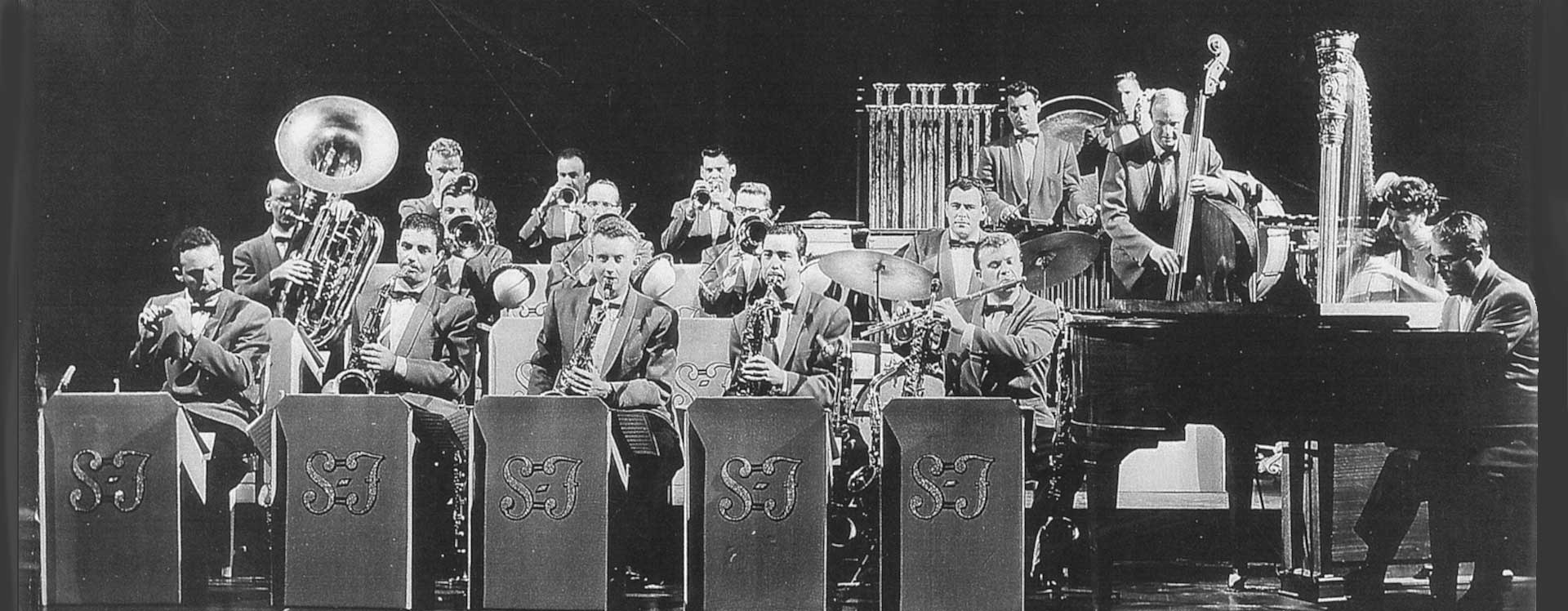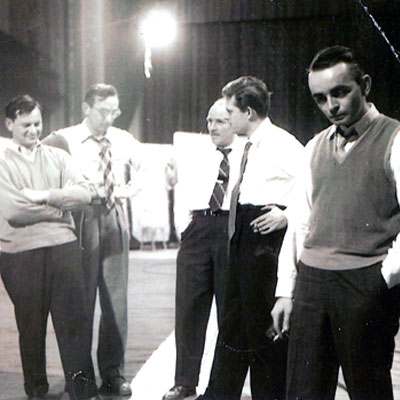

Photo above: The Sauter-Finegan Orchestra circa 1955. Below: Trigger Alpert, Eddie Sauter, Don Lamond, Mundell Lowe and Ralph Burns listening to a playback at Manhattan Center circa 1952.

Irv Dinkin
Willard Alexander
Dave Kapp
Around the same time that talk of a Sauter-Finegan collaboration emerged, Ray McKinley's trombonist, Irv Dinkin, went to work for Willard Alexander as an A&R man.
The Willard Alexander agency helped usher in the "Big Band Era" promoting names like Benny Goodman, Artie Shaw, and Count Basie among others. It was through Dinkin that Alexander became aware of Sauter's and Finegan's plans to team up.
Finegan recalled, "Willard was very interested. This was before we began. We didn't know what kind of band it was going to be stylistically...The one thing we had in mind was to have concerts and to record...[and] to be based in New York, not be a road band."
Dave Kapp, head of A&R at RCA Records, was immediately interested in recording whatever it was that the two creative composers decided to come up with.
Now it was time for the pair to decide upon a name. They spent months trying to think up a composite name for the ensemble. As Eddie recalled, "so long as it didn't have our names in it." However, at the discretion of the Willard Alexander Agency, they ended up being called the Sauter-Finegan Orchestra.
Musicians were brought in for a recording date on May 12, 1952. Through their shared networks during their big band era days, Sauter and Finegan were able to pool together some of the finest musicians in the New York area.
While the standard instrumentation of the big bands of the time was five reeds, four trumpets, four trombones, guitar, piano, bass, and drums, Sauter and Finegan altered this mix by reducing the component of trumpets to three, replacing the fourth trombone with a tuba and adding a harp, and two percussion chairs.
Throughout 1952, the band did several record dates that produced a wealth of the material that would come to be the band's "hits." Songs like "Tweedle Dee and Tweedle Dum" and the vocal hit "Nina Never Knew" made their way to the records and the public ate them up.
Owing to the overwhelming response to the 1952 recordings, it was decided (probably at the behest of the Willard Alexander Agency) that the Sauter-Finegan Orchestra would go on tour.

Recommended: Listen on headphones or external speakers.
Sauter-Finegan Orchestra
"Horseplay" – February 1953
Eddie Sauter composition
"Where or When" – October 1953
Eddie Sauter arrangement
Vocal by Sally Sweetland
OCTOBER 1953 BAND: Al Derisi, Bobby Nichols, Nick Travis (trumpet); Gil Cohen, Jimmy Thompson (trombone); Tom Mitchell (bass trombone); Harvey Phillips (tuba); Harvey Estrin, Wally Kane (alto sax); Al Block, Ray Shiner (tenor sax); Gene Allen (baritone sax); Harvey Estrin, Wally Kane (clarinet); Dan Finton (piano); Verley Mills (harp); Mundell Lowe (guitar); Max Bennett, (bass); Mousie Alexander (drums); Sperie Karas, Joe Venuto (percussion); Sally Sweetland, Andy Roberts (vocals); Eddie Sauter, Bill Finegan (arrangers, directors).
"We have very definite ideas of what should and shouldn't be, ideas that were gleaned from our years of experience" — 1953 program notes